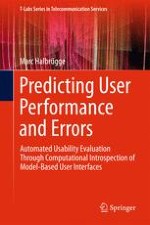This book proposes a combination of cognitive modeling with model-based user interface development to tackle the problem of maintaining the usability of applications that target several device types at once (e.g., desktop PC, smart phone, smart TV). Model-based applications provide interesting meta-information about the elements of the user interface (UI) that are accessible through computational introspection. Cognitive user models can capitalize on this meta-information to provide improved predictions of the interaction behavior of future human users of applications under development.
In order to achieve this, cognitive processes that link UI properties to usability aspects like effectiveness (user error) and efficiency (task completion time) are established empirically, are explained through cognitive modeling, and are validated in the course of this treatise. In the case of user error, the book develops an extended model of sequential action control based on the Memory for Goals theory and it is confirmed in different behavioral domains and experimental paradigms.
This new model of user cognition and behavior is implemented using the MeMo workbench and integrated with the model-based application framework MASP in order to provide automated usability predictions from early software development stages on. Finally, the validity of the resulting integrated system is confirmed by empirical data from a new application, eliciting unexpected behavioral patterns.
